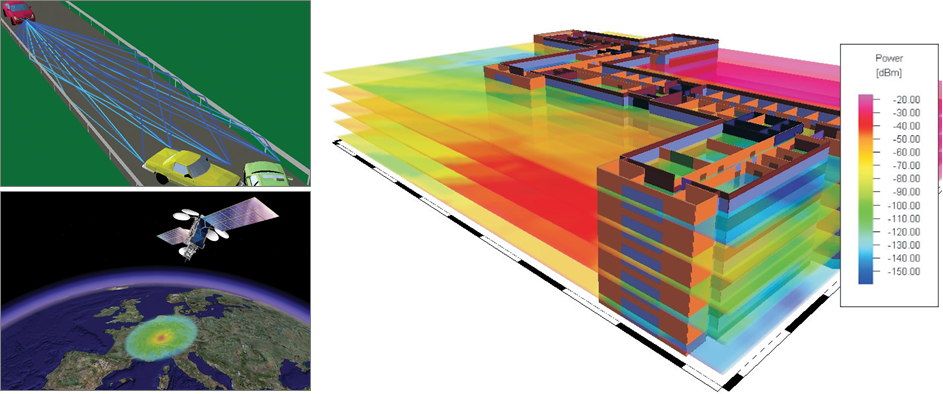WinProp Overview
WinProp is a comprehensive and leading simulation tool in the domain of wireless propagation and radio network planning.

Figure 1. Applications range from satellite to terrestrial, from rural via urban to indoor radio links.
Propagation Models
WinProp's powerful simulation methods are all high-frequency methods, valid when the geometrical features are much larger than the wavelength of the signal. Several methods are fully three-dimensional, consider 3D object data and compute all rays in 3D. Other focus on the vertical plane only.
- COST 231 extended Walfisch-Ikegami model
- Empirical vertical plane model with knife edge diffraction
- Urban dominant path model (DPM)
- 3D ray-tracing model
Besides the prediction of the path loss, the delay and angular spread can be computed as well as LOS / NLOS, directional channel impulse response, angular profile and propagation paths.
Databases
- Pixel database
- Typically used for rural/suburban scenarios. Elevations and optionally land usage are stored on a pixel by pixel basis.
- 2.5D Vector database
- Typically used for urban scenarios. Each building or vegetation object is described by a polygonal ground plane and an individual height above street level using polygonal cylinders. If the urban area is not flat, the topography can be included.
- 3D Vector database
- Typically used for indoor scenarios or small outdoor scenarios. Each building or other object is described by flat polygons with arbitrary orientations. This allows maximum geometrical freedom.
Computation and Simulation
WinProp allows the planning of coverage and capacity as well as network simulations (for example, the performance of algorithms, analysis of delays). Depending on the application, WinProp offers static, Monte-Carlo, and dynamic network simulators. You can define the (location dependent) traffic for circuit and for packet switched services (for example, statistical distributions and mobility).
Coverage
Different transmission modes can be defined (with parameters including bandwidth, coding schemes, required signal-to-noise-and-interference ratio, signal threshold, transmit power) upon which the coverage maps (for example, cell assignment, best server, active set, channel quality, received power in downlink and uplink, signal-to-noise-and-interference ratio) are computed individually for each transmission mode. Link adaptation is considered and depends on the channel quality predicted with the propagation models. Maximum received power as well as maximum achievable data rates, are predicted accurately for each location in the coverage area.Capacity
WinProp calculates the capacity (for example, throughput, maximum data rates, packet delays, QoS) of the different radio links and cells in the network based on the coverage analysis and the traffic assumptions. Capacity limitations and overloaded cells are detected easily and networks are optimized to provide both high capacity and throughput. Capacity improvements due to MIMO and / or beamforming are modeled accurately due to the sophisticated deterministic propagation models.
Arbitrary antenna configurations (linear, circular) are possible and their impact on the radio channel is determined during the propagation analysis.
WinProp API
The WinProp API enables flexible integration into other software tools.
A description of the API interface is available in the installation directory, together with C/C++ sample project for MS Visual Studio.
WinProp and Feko Interaction
Design the antenna and calculate the radiation characteristic in terms of a 3D antenna pattern using Feko. Then superimpose the far field on the 3D radio channels calculated with WinProp.
WinProp supports the import of antenna patterns from several sources, including Feko. You can design the antennas and calculate the radiation patterns in Feko, and use those patterns to represent transmitting and receiving antennas in the radio channel analysis in WinProp.
WinProp also supports the import and processing of radar cross section patterns calculated by Feko. To accelerate certain simulations in WinProp, for example, for automotive RADAR, complex vehicles can be substituted by their radar cross sections.
Updater
WinProp has an updater utility that allows you the flexibility to install an update containing new features, minor software enhancements and bug fixes on top of an existing base installation. Use the Launcher utility to launch the Updater.
Altair Units
WinProp is part of the Altair Units based licensing system which allows metered usage of the entire Altair suite of products. This value-based licensing model has been extended to Altair's extensive partner network, providing the most comprehensive and dynamic set of solutions to the market.